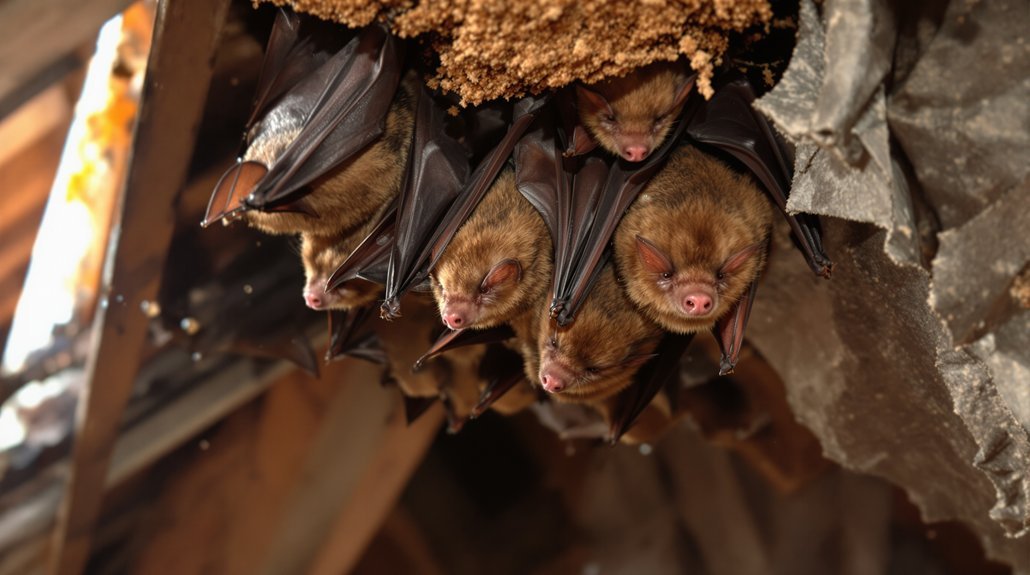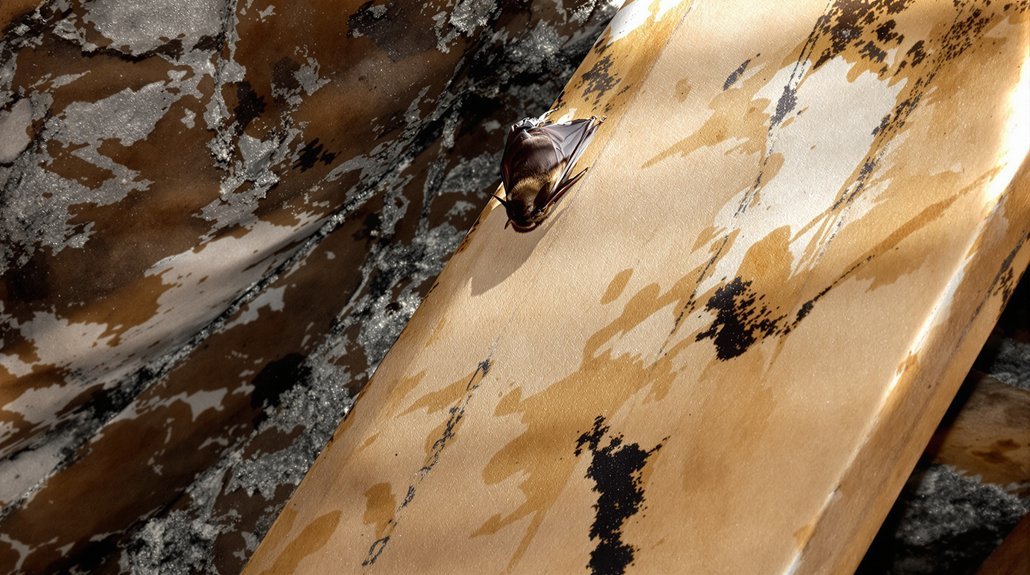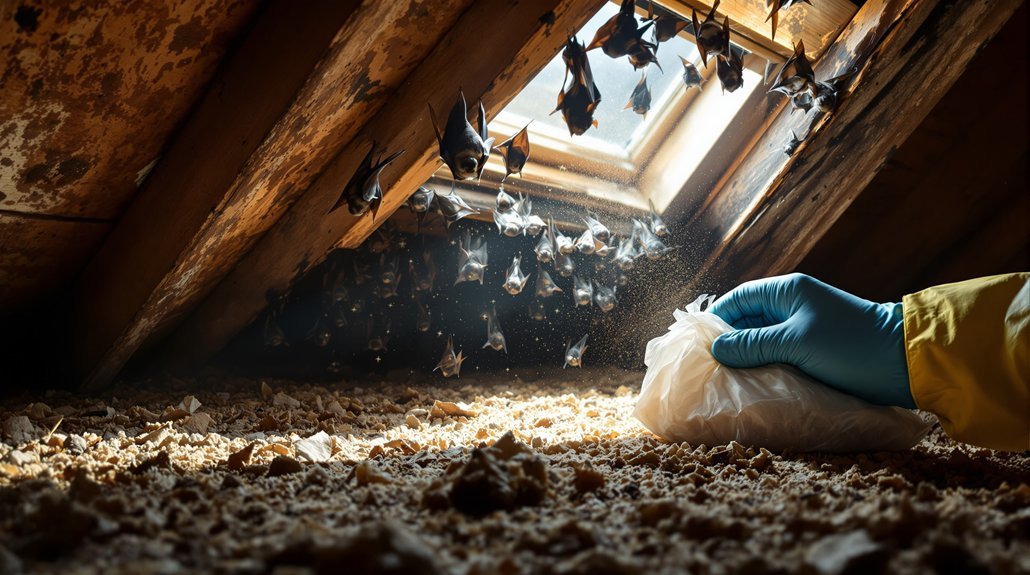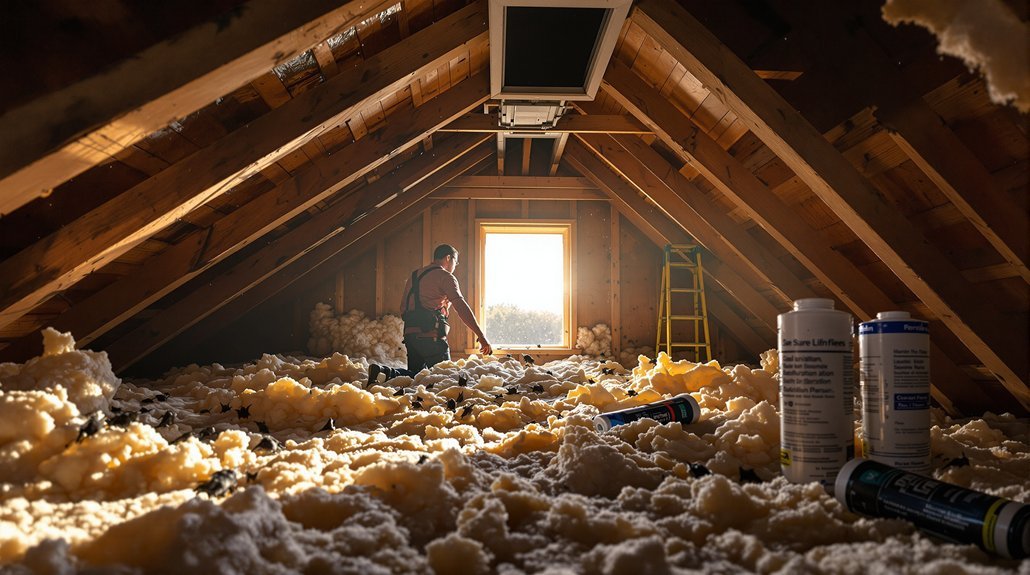To get rid of bats in the attic in Des Moines, first identify signs like sounds, droppings, or stains. Legal restrictions apply, so be aware of local rules on removal. Seal any gaps or cracks to prevent entry, and consider using one-way exclusion devices. It’s essential to clean up guano to avoid health risks. If issues persist or you’re unsure, seeking professional help might be the best option for a bat-free home. More helpful tips await!
Key Article Highlights
- Identify signs of bat infestation, such as droppings or high-pitched sounds, to confirm their presence in your attic.
- Check local laws for bat protection and obtain necessary permits before attempting any removal or exclusion methods.
- Seal all potential entry points, including gaps and cracks, to prevent bats from re-entering after removal.
- Use one-way exclusion devices to allow bats to exit while preventing their return, ideally during late summer or early fall.
- Consider contacting a professional for safe removal and legal compliance, especially if dealing with a large colony or health risks.
Understanding Bat Behavior and Habitats

While many people may fear bats, understanding their behavior and habitats can help demystify these creatures. Bats are unique because they are the only flying mammals. Their bat flight patterns are quite remarkable, allowing them to navigate through the dark with ease. They use echolocation to find food and avoid obstacles, which is a key part of their nocturnal activity. Most bats come out at night to hunt insects, making them important for controlling pest populations. They prefer to roost in dark, sheltered areas like attics, caves, and trees. Knowing where bats like to hang out can help people manage their presence better. By learning about bats, one can appreciate their role in nature and reduce fear. Additionally, understanding their entry points and roosting sites can aid in effective bat management and removal. Recognizing their behavior patterns can also help determine the best times and methods for exclusion and repair.
Identifying Signs of a Bat Infestation

When homeowners suspect a bat infestation, recognizing the signs early can make a big difference in addressing the issue. One of the first indicators is the sound of bat vocalizations, which can be heard as high-pitched squeaks or chirps, especially during dusk and dawn. Another clear sign is guano accumulation, as bat droppings can pile up in attics and along entry points. This droppings can appear dark and crumbly, often resembling mouse droppings but larger. Homeowners should also look for stains on walls or ceilings, indicating where bats may be roosting. Additionally, noticing a sudden increase in flying insects inside the home may signal that bats are nearby, as they often attract insects to feed on.
Health Risks Associated With Bats

What health risks do bats pose to humans? Bats can carry diseases like rabies, which can be dangerous if transmitted through bites or scratches. Their droppings, known as guano, can lead to respiratory issues when inhaled. Bats use bat echolocation to navigate and find food, but their close roosting patterns in attics can create unsanitary conditions. This can attract pests and cause structural damage, further complicating health risks. Additionally, histoplasmosis, a lung disease caused by a fungus in bat droppings, is a concern for those living near bat colonies. Understanding these risks is vital for homeowners to take appropriate action and protect their health while dealing with a bat infestation.
Legal Considerations for Bat Removal
When dealing with bat removal in Des Moines, it’s important to know the local wildlife laws. Some bat species are protected, so homeowners need to be aware of any endangered species regulations. Additionally, getting the right permits may be necessary before taking action.
Local Wildlife Laws
Local wildlife laws play a vital role in the process of bat removal in Des Moines. Bats are protected under state regulations, making it crucial for homeowners to understand the legalities involved. These laws often focus on the bats’ nocturnal behavior and their seasonal flight patterns. For instance, bat removal is typically restricted during their breeding season, which means waiting until the young are able to fly away. Ignoring these laws can lead to hefty fines and legal trouble. Hence, it’s essential to consult with wildlife experts or pest control professionals who are familiar with local regulations. This ensures a smooth and lawful removal process while respecting the natural habitat of these creatures.
Endangered Species Protection
Endangered species protection adds another layer of complexity to bat removal in Des Moines. Some bat species are protected due to their declining populations, which makes any removal effort more challenging. Understanding their diet and roost preferences is vital for those looking to manage bats responsibly.
- Bat Diet: Many bats feed on insects, making them beneficial for pest control.
- Roost Preferences: Bats often choose attics or old buildings for shelter, impacting removal strategies.
- Legal Compliance: Always check local laws before attempting removal to avoid penalties.
When dealing with bats, it’s important to take these legal factors into account to ensure both safety and compliance. This knowledge can help homeowners navigate the complexities of bat removal effectively.
Permitting Requirements Explained
Removing bats from an attic in Des Moines often requires understanding the permitting process. Bats play a vital role in the local bat ecology, and removal must comply with laws protecting them. Before taking action, it’s essential to know the regulations regarding their roosting sites. Here’s a simple table summarizing the key permitting requirements:
| Requirement | Description | Notes |
|---|---|---|
| Permits Needed | Yes, for removal activities | Contact local authorities |
| Timing | Seasonal restrictions may apply | Avoid spring and summer |
| Species Identification | Identify if protected species are present | Consult a professional |
| Habitat Assessment | Assess roosting sites | Required for permit approval |
| Compliance | Follow guidelines set by wildlife agencies | Essential for legal removal |
Understanding these requirements will help guarantee a smooth bat removal process.
DIY Bat Removal Techniques
While dealing with bats in the attic can be a challenging task, there are several DIY removal techniques that homeowners in Des Moines can try. Understanding bat behavior and their roosting habits is *essential* for effective removal. Here are some practical methods:
- Seal Entry Points: Identify and close any gaps or holes where bats might enter.
- Use Light and Sound: Bats prefer dark, quiet spaces, so introducing light and noise can encourage them to leave.
- Create a Bat House: Offering a nearby alternative can attract bats away from the attic.
These techniques can help homeowners manage their bat problem safely and effectively. However, patience is key, as bats may take time to vacate their roost.
Using Bat Exclusion Devices
Using bat exclusion devices can be an effective way to encourage bats to leave an attic without harming them. These devices allow bats to exit their roost sites but prevent them from returning. They work by creating a one-way passage that bats can easily use to escape. This method is often best used in late summer or early fall when baby bats have matured and are ready to fly. It’s also important to clean up any bat guano left behind, as it can pose health risks. By effectively using exclusion devices, homeowners can resolve their bat issues while ensuring the safety and well-being of these beneficial creatures. Properly managing bat populations helps maintain a healthy ecosystem.
Importance of Sealing Entry Points
Sealing entry points is essential for preventing bats from returning to an attic after they have been excluded. Once bats have been removed, it’s important to make sure they can’t get back in. This step is necessary for effective pest management and ensures a bat-free environment.
Sealing entry points is crucial to ensure bats don’t return after exclusion, maintaining a pest-free attic environment.
- Inspect for cracks and gaps in walls and roofs.
- Use materials like caulk or metal mesh to seal openings.
- Regularly check for new entry points, especially after storms.
Preventative Measures to Keep Bats Away
To keep bats from returning, it’s important to take some simple steps. First, sealing entry points will help block them from getting inside. Next, removing food sources and installing bat houses can also make a big difference.
Seal Entry Points
A crucial step in keeping bats out of the attic is sealing any entry points they might use to get inside. Bats are small and can squeeze through tiny gaps, so it’s essential to be thorough. Inspect the attic and surrounding areas, especially around windows, vents, and rooflines.
To effectively seal bat entry points, consider the following tips:
- Use caulk or foam insulation to fill cracks and gaps.
- Install screens on attic ventilation openings to prevent access.
- Repair any broken shingles or holes in the roof.
Remove Food Sources
While bats are often seen as beneficial for controlling insect populations, their presence in an attic can create issues, especially when food sources attract them. To help keep bats away, it’s essential to remove any nearby food sources. This includes managing outdoor lighting that attracts insects, as bats often hunt in the dark. Additionally, homeowners should trim back overgrown vegetation that could harbor insects. By reducing these food sources, the likelihood of bats finding roosting sites nearby decreases considerably. It’s also wise to ensure that garbage cans are sealed tightly, as leftover food can attract insects and, in turn, bats. By taking these steps, homeowners can make their property less appealing to these flying mammals.
Install Bat Houses
By installing bat houses, homeowners can provide a safe and inviting alternative for bats, steering them away from attics and other unwanted areas. These structures allow bats to thrive while promoting bat communication and using echolocation techniques to find their way. Here are some benefits of bat houses:
- Natural Pest Control: Bats consume large amounts of insects, reducing the need for pesticides.
- Habitat Preservation: Bat houses help protect local bat populations by offering a secure place to roost.
- Educational Opportunities: Observing bats can be a fun way to learn about wildlife and ecosystems.
When to Call a Professional Bat Removal Service
Knowing when to call a professional bat removal service can save homeowners from potential health risks and property damage. If bats are spotted frequently during their nocturnal activity or heard using their bat echolocation, it’s a sign they may have taken up residence. Homeowners should act quickly if they notice droppings or a sudden influx of these creatures. Trying to remove bats without proper training can lead to injury or exposure to diseases. Additionally, if there’s uncertainty about how to safely identify or seal entry points, professional help is essential. Experts have the tools and knowledge to manage the situation effectively. In short, when bats become a nuisance, it’s wise to bring in the professionals.
Maintaining a Bat-Free Environment
To keep bats away from the attic, regular checks are important. Homeowners should seal any entry points and use bat-repellent solutions to discourage these creatures. Staying proactive can help maintain a bat-free environment.
Regular Inspections and Maintenance
Regular inspections and maintenance play a crucial role in keeping homes bat-free. Homeowners should regularly check for signs of bat activity, especially during peak nocturnal activity times. Understanding bat flight patterns can help identify areas where bats might enter.
- Inspect attics and roofs for potential entry points.
- Look for droppings or urine stains, which indicate presence.
- Keep outdoor lights on at night to deter bats from roosting nearby.
Seal Entry Points
Sealing entry points is vital for maintaining a bat-free environment in any home. Bats can squeeze through surprisingly small openings, so it’s important to inspect the house thoroughly. Homeowners should check around windows, doors, and the roof for cracks or gaps. After finding these entry points, sealing them with caulk or mesh can keep bats out. Additionally, keeping garden plants trimmed and away from the house can reduce hiding spots. Bird feeders can also attract insects, which may draw bats closer. By managing these features, homeowners can create a less inviting space for bats. Taking these proactive steps is essential for preventing future infestations and ensuring a peaceful, bat-free attic.
Bat-Repellent Solutions
While sealing entry points is crucial, using bat-repellent solutions can further guarantee a bat-free environment. Understanding bat behavior helps in choosing effective methods. Many repellents can deter these creatures without harming them or disrupting wildlife shelters. Here are some popular options:
- Ultrasonic devices: These emit high-frequency sounds that bats find unpleasant.
- Natural repellents: Essential oils like peppermint or eucalyptus can be used to create a barrier.
- Bright lights: Bats prefer dark areas, so brightening the attic can be less inviting.
Implementing these solutions can make the attic less appealing to bats, ensuring they stay away for good. A combination of sealing and repelling is key to maintaining a bat-free home.

